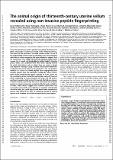Files in this item
Animal origin of 13th-century uterine vellum revealed using noninvasive peptide fingerprinting
Item metadata
| dc.contributor.author | Fiddyment, Sarah | |
| dc.contributor.author | Holsinger, Bruce | |
| dc.contributor.author | Ruzzier, Chiara | |
| dc.contributor.author | Devine, Alexander | |
| dc.contributor.author | Binois, Annelise | |
| dc.contributor.author | Albarella, Umberto | |
| dc.contributor.author | Fischer, Roman | |
| dc.contributor.author | Nichols, Emma | |
| dc.contributor.author | Curtis, Antoinette | |
| dc.contributor.author | Cheese, Edward | |
| dc.contributor.author | Teasdale, Matthew D. | |
| dc.contributor.author | Checkley-Scott, Caroline | |
| dc.contributor.author | Milner, Stephen J. | |
| dc.contributor.author | Rudy, Kathryn Margaret | |
| dc.contributor.author | Johnson, Eric J. | |
| dc.contributor.author | Vnouček, Jiří | |
| dc.contributor.author | Garrison, Mary | |
| dc.contributor.author | McGrory, Simon | |
| dc.contributor.author | Bradley, Daniel G. | |
| dc.contributor.author | Collins, Matthew J. | |
| dc.date.accessioned | 2016-06-22T23:31:01Z | |
| dc.date.available | 2016-06-22T23:31:01Z | |
| dc.date.issued | 2015-12-08 | |
| dc.identifier | 239828297 | |
| dc.identifier | bc23fc09-18d4-4403-9e73-926d109d41ca | |
| dc.identifier | 84949267028 | |
| dc.identifier | 000365989800035 | |
| dc.identifier.citation | Fiddyment , S , Holsinger , B , Ruzzier , C , Devine , A , Binois , A , Albarella , U , Fischer , R , Nichols , E , Curtis , A , Cheese , E , Teasdale , M D , Checkley-Scott , C , Milner , S J , Rudy , K M , Johnson , E J , Vnouček , J , Garrison , M , McGrory , S , Bradley , D G & Collins , M J 2015 , ' Animal origin of 13th-century uterine vellum revealed using noninvasive peptide fingerprinting ' , Proceedings of the National Academy of Sciences of the United States of America , vol. 112 , no. 49 , pp. 15066-15071 . https://doi.org/10.1073/pnas.1512264112 | en |
| dc.identifier.issn | 1091-6490 | |
| dc.identifier.other | ORCID: /0000-0002-1633-7607/work/54819179 | |
| dc.identifier.uri | https://hdl.handle.net/10023/9040 | |
| dc.description | The authors acknowledge Science Foundation Ireland European Research Council (ERC) Support Award 12/ERC/B2227, Valeria Mattiangeli, and the Trinity Genome Sequencing Laboratory (TrinSeq) for MiSeq support. This work was supported by the Marie Curie International Fellowship PALIMPSEST FP7-PEOPLE-2011-IEF 299101, a University of Manchester Research Institute seedcorn grant, British Academy Postdoctoral Fellowship funding, and ERC Investigator Grant 295729-CodeX. | en |
| dc.description.abstract | Tissue-thin parchment made it possible to produce the first pocket Bibles: Thousands were made in the 13th century. The source of this parchment, often called “uterine vellum,” has been a long-standing controversy in codicology. Use of the Latin term abortivum in many sources has led some scholars to suggest that the skin of fetal calves or sheep was used. Others have argued that it would not be possible to sustain herds if so many pocket Bibles were produced from fetal skins, arguing instead for unexpected alternatives, such as rabbit. Here, we report a simple and objective technique using standard conservation treatments to identify the animal origin of parchment. The noninvasive method is a variant on zooarchaeology by mass spectrometry (ZooMS) peptide mass fingerprinting but extracts protein from the parchment surface by using an electrostatic charge generated by gentle rubbing of a PVC eraser on the membrane surface. Using this method, we analyzed 72 pocket Bibles originating in France, England, and Italy and 293 additional parchment samples that bracket this period. We found no evidence for the use of unexpected animals; however, we did identify the use of more than one mammal species in a single manuscript, consistent with the local availability of hides. These results suggest that ultrafine vellum does not necessarily derive from the use of abortive or newborn animals with ultrathin hides, but could equally well reflect a production process that allowed the skins of maturing animals of several species to be rendered into vellum of equal quality and fineness. | |
| dc.format.extent | 6 | |
| dc.format.extent | 798554 | |
| dc.language.iso | eng | |
| dc.relation.ispartof | Proceedings of the National Academy of Sciences of the United States of America | en |
| dc.subject | Pocket Bible | en |
| dc.subject | Parchment | en |
| dc.subject | Vellum | en |
| dc.subject | Collagen | en |
| dc.subject | Mass spectrometry | en |
| dc.subject | D History (General) | en |
| dc.subject.lcc | D1 | en |
| dc.title | Animal origin of 13th-century uterine vellum revealed using noninvasive peptide fingerprinting | en |
| dc.type | Journal article | en |
| dc.contributor.institution | University of St Andrews. School of Art History | en |
| dc.contributor.institution | University of St Andrews. St Andrews Institute of Medieval Studies | en |
| dc.identifier.doi | https://doi.org/10.1073/pnas.1512264112 | |
| dc.description.status | Peer reviewed | en |
| dc.date.embargoedUntil | 2016-06-23 | |
| dc.identifier.url | http://europepmc.org/abstract/MED/26598667 | en |
| dc.identifier.url | http://www.pnas.org/lookup/suppl/doi:10.1073/pnas.1512264112/-/DCSupplemental | en |
This item appears in the following Collection(s)
Items in the St Andrews Research Repository are protected by copyright, with all rights reserved, unless otherwise indicated.

